|
Score: 90/100 (9.0 out of 10)
Any Rhyme at All Terri Whitney is a poetry-filled love letter to arguably the greatest and most influential band in history, The Beatles! Four lads from Liverpool—John Lennon, Paul McCartney, George Harrison, and Ringo Starr—took the world by storm in the 1960s and, in a sense, have yet to relinquish their grasp on the human imagination. Whitney calls The Beatles “the best band of yesterday, today and always.” Terri Whitney's poetry book is a perfect example of how the life and legacy of The Beatles still lives on into the 2020s. And what's really special about all of this is that it introduces this incredible band to a new generation of people who may not know or be able to appreciate how great they were (and, in some cases, still are). Something that really stood out to us was how much this band meant to the individual: Terri Whitney. Whitney stands in for and represents Beatles fans around the world. At the same time, this fandom is immensely passionate and personal. This is encapsulated in the poem I Am a Beatle Fan. This poem brought up a question in our minds: Why do we become fans of things? Ultimately, it's because we feel that these things bring us joy. They pick us up when we're feeling down. They distract us from harsh realities and the hardships of life. They give us something to look forward to. They give us a reason to get out of bed in the morning. They bring us together to enjoy, celebrate, and appreciate our fandom with other like-minded people. So, because of that, we invest in the things we love. We spend time, energy, and money on them. We do it because we care, and because it brings us happiness. It's like spending money on baseball tickets or video games, in a sense. Fittingly, one of the best verses from this book reads: “From Vinyl 45s to Vinyl LPs Lest we forget 8-tracks, cassettes and CDs I listen, I read and collect what I can Forever I will be a diehard Beatle Fan” Now, beside this verse and a few like it, the poems in this book are mostly simplistic, usually employing quatrains or four-line stanzas with an ABAB rhyme scheme. This is, for all intents and purposes, one of the the simplest of all rhyme schemes. It's what you'll usually see in children's books (like Dr. Seuss) or chanted by a cheerleader team at a sporting event. While this rhyme scheme isn't always used, it probably makes up at least 85% of the book. And that's fine! It's like Toyota Corollas, they're popular because they work. Some of the rhymes are actually quite clever. One of our favorites was reading “boots” and “suits” paired together. Now, the writing in this book was mostly good, but there were a few errors. For example, there is an extra letter “S” left hanging on page 74 (between the words “guitar” and “sing”). This is ironic because this is probably our favorite line in the book, alluding to the Beatles song, While My Guitar Gently Weeps. Also, a lot of sections of that poem are left hanging or “orphaned” on their own lines for no discernible reason other than the font or font-size wasn't modified to accommodate keeping them on the prior line. This doesn't appear to be a problem with any of the other poems. Perhaps that section was overlooked in editing? One thing we really didn't expect to feel from this book was sadness and emotion. This wasn't the kind of book that we'd expect would make us cry. Well, there are several poems and sections of this book that concern the deaths of several members of the band (and their associates/partners). Perhaps the one that should be obvious to everyone is the assassination of John Lennon by a crazed fan. What's a bit special about the poem concerning Lennon's death is that it relishes in the fact that he did not die alone. Yes, of all people, Yoko Ono—the controversial, much-hated wife of John Lennon—was there for him in his dying moments. That's something that even we didn't consider. The book also deflects some of the usual blame away from Yoko Ono, usually the scapegoat of the band's collapse, by explaining that many of the band members were distracted and unhappy in one way or another. Another example of this book bringing out emotions is when discussing Paul McCartney's beloved wife, Linda, who is honored in a poem in this book. The poem that bears her name tells the story of her battle with cancer and her undying devotion to Paul and his work through the years. Incredibly, we were amazed to learn that several members of the original band are still alive and even performing! In fact, apparently, Paul McCartney and Ringo Starr reunited and even performed together on tour! That's amazing! Lastly, the art—while not the Mona Lisa—is something to be admired. The cover reflects the funny, cartoonish, caricatured appearance of the band members in their animated flicks or in Yellow Submarine. What really impressed us were the sketches of the individual band members and their associates. They're actually really good! Check this out on Amazon if you love The Beatles and/or 60s rock & roll!
0 Comments
Score: 92/100 (9.2 out of 10)
Each pet—like each human being—is unique and special. Each has their own personality and their own inclinations. Peach and Jake Celebrate Christmas is a fantastic and adorable demonstration of these facts, showing us that two four-legged friends of the same breed can still have very different personalities and approaches to the same or similar situations. On one side, we have Peach, an adorable six-year-old female Goldie with a more cautious and calm personality. On the other side, we have Jake, a big, handsome eight-year-old male Goldie with a rambunctious and playful personality (ok, at least when's not trying to wake up from a night's rest). It seems clear that Jake is the kind of dog that'll sprint outside to chase and bark at squirrels. Peach, on the other hand, is the kind of dog that'll wait at the window or stand in the doorway and watch the shenanigans go down. This book follows both Jake and Peach as they experience an exciting, eventful Christmas together. Specifically, we get to see how the two pups respond to getting two toys as Christmas presents. It is so fascinating and interesting to see how the pups react differently to these presents! Jake reacts in his playful, rambunctious, gung-ho way. He goes to town on his squeaky toy, Mr. Moose (“Moosie”), quickly ripping it up and causing all the white stuffing to fall out of it. However, amusingly, Jake still treats Moosie like a full, complete toy even in the absence of stuffing. We found that both sweet and hilarious! Peach reacts with caution and even apprehension, not knowing what exactly she's supposed to do with her new squeaky toy, Foxie. In the end, she resorts to just snuggling and cuddling up next to it while she naps, treating it like a teddy bear. Something else that's really sweet and compelling are the interactions between the two dogs. Despite having very different personalities, they complement each other so well, like Yin & Yang. Peach is able to see that her big brother is tempted to sleep in, so she gently nudges him to wake up by “stretching” next to him. She is also able to see that Jake really loves to play with his Moosie, so she joins him in playing with it. Furthermore, Jake has the sensitivity and awareness to respect that Foxie is Peach's toy, and that Peach might not like him taking or playing rough with it. So, Jake actually leaves Foxie alone, helping keep it in pristine condition! It's amazing how these dogs that are so different can also be sensitive to each other's wants and needs. This book is a bundle of happiness, cuteness, and joy. It's not perfect, however, it has it where it matters. The photographs are fine to good. They aren't always the sharpest photographs, especially when the camera or the dogs are moving, but they're good enough for us to tell what's going on. There are times like on page 31 when the image is a bit blurry. Also, on page 9 when there appear to marks over where Peach's back is, likely caused by an accident on the smartphone, Microsoft Paint, or whatever editing software the author used. All in all, this is a really enjoyable experience. Check it out on Amazon! Score: 94+/100 (9.4+ out of 10)
Cheerful Obedience by Patrick McLaughlin follows an American soldier named Conor Patrick McKall during the tumultuous and violent Vietnam War. This is a special book that closely focuses on soldiers as human beings rather than expendable weapons or pawns on a chess board. The book focuses on the human aspects of the war rather than solely on the “action” or violence of warfare itself. We get to know Conor McKall as a young man with interests that fall outside of fighting. He is a loving son, a football fan, a proud American, and a loyal friend. Not only does he develop into a capable airborne infantryman, but he grows into a competent leader in his platoon and—ultimately—a hero in a war against a dangerous and determined enemy. We've all seen our fair share of Vietnam movies. We've read our fair share of Vietnam literature. Most of them, we'd say, our pretty good! This book is unique in the sense that it's more focused on the life and experiences of the individual soldier than on the grand, bloody conflict as a whole. Conor McKall is a very real-seeming, down-to-earth, and relatable protagonist. He could be any of us, really. Something that really endeared us with Conor is that he is a football fan. In fact, one of the first relatable moments in the book is when he and a fellow soldier make a bet over a college football game. And it's not just any college football game, it's the “Game of the Century” between Notre Dame and Michigan State, the game which infamously ended in a tie. This tells us a number of things about Conor, but does so subtly. 1. He is a typical young American man who loves football, 2. He is probably Catholic, 3. He is of Irish descent, 4. His family were probably European immigrants. The fact that we can gather all this information about a character from such a mundane scene is telling. Something else that stands out about Conor is that he is a person of honor and integrity. The key moment that points this out is when one of his fellow soldiers is under investigation for intentional self-injury and negligence. Instead of throwing the soldier under the bus or letting this injustice happen, Conor stands up for the soldier, vouches for him, and explains that there may be an alternate explanation due to an accident in cleaning a weapon. Conor could have easily let this other soldier be reprimanded and courtmarshalled, but he did the right thing—the hard and courageous thing instead. The book points out a lot of the ironies of war for these young men. For example, these men are old enough to wield an M-16, fight, and die, yet they're not considered old enough to purchase alcohol. There's also the irony that these young men are in the prime of their lives, at the best time to start a business, go to college, get married, and start a family, and yet they're being sent across the world to potentially die in a foreign war. Another thing that this book does right is in capturing the tension of a potential ambush. The Viet Cong were a guerrilla force that preyed on ambushing and picking off the Americans. The Americans, as this book describes, were following a directive to “seek and destroy” the enemy. In other words, there were no objectives of the Vietnam War other than to kill as many of the enemy as possible until they got too discouraged to fight. So, Conor and his platoon are constantly in a rough spot. At times, they are practically sitting ducks, although they do everything in their power to protect themselves. Death still lingers around every corner. In one scene, Conor's platoon is given terrible rules of engagement, directed not to fire unless fired upon. This, however, makes them even more vulnerable. Conor being Conor stands up for his platoon and challenges these rules of engagement, arguing that his men have the right to defend themselves and to take the initiative. The book also does a great job at showing us the weapons and vehicles used in the war, for example Puff the Magic Dragon, the M16s, M14s, and M60s. For some reason, our interest and attention did dip about four hours (250 pages) into reading this book. We're not quite sure why, but it seemed like the actual combat wasn't as compelling as the character work that occurred earlier in the book. Still, this is a very worthwhile read. This book does an excellent job at showing that 99%+ of American soldiers who fought in the Vietnam War were just men who were doing their jobs, not the monsters they were portrayed as in the media. Check it out on Amazon! Score 94/100 (9.4 out of 10)
We were pleasantly surprised by this highly educational children's book by Conrad J. Storad! This delightful children's book follows a little unnamed Story Monster (who serves as a surrogate for the young audience) as he finds himself on the Earth at night. Rather than being alone as one might expect at such an hour, Story Monster encounters an intelligent and friendly owl named Eddie (Eduardo E. Owlington VIII) who serves as the narrator for most of the book. Eddie is knowledgeable about all of the incredible, amazing animals who are active during the night. From Eddie (and the author), we learn about various types of owls, bats, ringtails, raccoons, opossums, red foxes, wolves, coyotes, armadillos, skunks, mosquitoes, fireflies, katydids, crickets, cicadas, moths, spiders, scorpions, frogs, toads, and snakes (don't worry if you have a phobia, the snakes aren't shown). We simply did not expect to step into such a deep, vast well of knowledge when opening this book. We were just expecting something simple and, admittedly, a bit more shallow. Instead, this book is an elaborate educational experience and a wealth of information! We did not expect to learn so much from a little children's book! For example, we didn't know that red foxes are one of the most widespread meat-eaters found around the world and have 20 different calls. We didn't know that brown bats can eat over 1,000 mosquitoes per hour. We didn't know that ringtails (“miner's cats”) are more closely related to raccoons than cats. We didn't know that raccoons were such great swimmers. We didn't know that opossums are related to animals more famously found in Australia, namely kangaroos and koalas. We didn't know that coyotes can use ten different sounds to communicate. We didn't realize that skunks and armadillos are nocturnal. We didn't know that there were four different kinds of skunks in North America. We didn't know that there were over 4,000 types of spiders in North America. We didn't know that fireflies are actually flying beetles. You and your children will definitely learn a lot from reading this book! Now, we have to say, this book took a while to win us over. At first, it came across as a bit unfinished and a bit clunky. One thing that immediately stood out to us is that, unlike Story Monsters (the previous book), the illustrations distinctly lack color. However, the more we thought about it, we realized it doesn't really need color. Kids don't always have to be bombarded with bright colors. It can be overwhelming. Heck, parents might find the opportunity to copy some of these pages and use them as coloring pages. Kids love coloring books. On the note of clunkiness, the main character doesn't have a name and we're not sure how or why they showed up on Earth at this specific time, we just have to accept it. Also, we weren't expecting the book to be more like a survey or overview of a lot of information rather than a typical linear narrative. In other words, there isn't really a story other than Story Monster learning from Eddie and becoming more comfortable and knowledgeable about this unfamiliar environment. It is true that dark, night, and certain animals can be terrifying to children (heck, even adults) mostly because of the mystery and unfamiliarity they hold. It's easy to feel alone at night or in the dark because you can't see as much. However, kids may be comforted and delighted to know that certain cool and even cuddly animals actually love to hang out and play at night. Story Monster and Eddie are both very lovable and likable characters. Eddie is so much fun to learn from and listen to! On the other side, it's fun to see Story Monster transform (and attempt to transform) into these different animals. This gives parents and teachers opportunities to ask interactive questions of their kids such as, “What animal is Story Monster turning into now?” What a remarkable educational opportunity for children! Check it out on Amazon! Score: 90/100 (9.0 out of 10)
The Age of Heroes by Mikhail Gladkikh is an ambitious historical-fiction/mythology novel that follows multiple Eastern Mediterranean civilizations as they come to blows while under the influence of aliens (“Soarers”) whom they perceive to be gods. This book is truly distinctly ambitious and epic in scale, both to its benefit and detriment. There are times when there definitely seems to be too much going on. There are also times when the book seems to lack focus. However, it most certainly isn't dull or boring, and there's a lot to sink your teeth into. This book takes place during the Bronze Age around the Mediterranean. Several space-faring aliens come upon the Earth and humanity, contemplating how they will go forward with their plans (and, at times, lack thereof). For the most part, the aliens (perceived as gods by the humans) seem to view humanity and their planet as a game board to play and experiment on. It's a little bit along the lines of The Iliad, which is certainly a direct inspiration for the novel, even prominently featuring the Trojan War. There are a lot of conflicts going on in this book from the conflicts between the feuding Greek gods (Zeus, Athena, Aphrodite, and Poseidon), the aforementioned build up to the Trojan War, the conquests of the genocidal and religiously-fanatical King Ninurta of Assyria, King Echeleos's bids to pimp out his gorgeous Hittite daughter to form political alliances, and Khay's awakening of an ancient evil in Egypt. Achilles is in here as well as Hercules. It is possible to find some depth and intrigue in these various conflicts. However, what actually stood out to us was the father-daughter relationship between King Echeleos and Princess Elhi-Nikkal. Princess Elhi-Nikkal almost seemed like the main character in this chaotic, ensemble cast of characters and their various issues. She seems to be the most down-to-earth character in a cast of alien-gods and kings. She is vulnerable enough to add tension to the story yet strong and clever enough to be a compelling protagonist. This book seems to be written and constructed for lovers of mythology and history. With that said, as lovers of mythology, there were aspects of this book that really bothered us. First and foremost, the characterization of Zeus is just plain wrong. Zeus or “Commander” is ridiculously humble and neutered. He constantly reminds the other characters that he is not a god and can be killed like anyone else. He is also incredibly good-natured, overly so. Keep in mind that this is Zeus, one of the naughtiest and controversial of all mythological characters—a character who slept with pretty much everything under the sun, whether they were willing or not. That's not even mentioning the number of characters he tortured, dismembered, and murdered in Greek mythology. Suddenly, he's portrayed as a nigh-perfectly benign and benevolent being in this novel. That really bothered us. If you're coming into this novel to see an authentic portrayal of Greek myth, then this isn't it. However, it is its own unique take on the mythos and genre. There's a lot of action and drama in this book including some big battles and duels, something which fantasy and epic lovers will be happy about. Check it out on Amazon! Score: 95/100 (9.5 out of 10)
Tales of Monstrosity is a magnificent, entertaining, and—at times—terrifying short-story collection compiled by Marx Pyle. It features horror, cryptid, and monster stories by Pyle, Scott A. Johnson, Anne C. Lynch, Sen R.L. Scherb, W.H. Horner, Carrie Gessner, Kevin Plybon, Katharine Dow, Victoria L. Scott, Jeremiah Dylan Cook, J.C. Mastro, Sophia DeSensi, Jeannie Rivera, Michael La Ronn, Marisa Wolf, Jeff Burns, Francis Fernandez, Colten Fisher, and G.K. White. This is an extremely talented group of storytellers! About half of these contributors have won an Outstanding Creator Award (or more) in the past, either for their contributions to the Dragons of a Different Tail collection (also compiled by Pyle) or independently. For example, Jeannie Rivera is the author of the stellar Frederick Moody and the Secrets of Six Summit Lake, which won us over with its two lead characters. J.C. Mastro is the author of Academy Bound, a thrilling story about hopeful young space cadets. Marx Pyle once again proves to be a phenomenal compiler of compelling, funny, entertaining, and thematically consistent short-stories. Demonstrating this, this collection kicks off perfectly with El Cucuy by Scott A. Johnson, instantly the most tense and suspenseful story in the book. A father haunted by his past (both literally and figuratively) is stalked by a malevolent creature who he fears will take and kill his little daughter. This story is genuinely suspenseful as we are immediately introduced to true and dire stakes: children taken away by this terrifying, mysterious creature—El Cucuy—and later found petrified in trees, their faces still showing terror. This monstrous creature is said to lurk under your bed and to pull you away when you are sleeping and, thus, most vulnerable. There's something familiar, morbid, and compelling about this. We've all heard stories of the Boogeyman, or the monster under the bed, or the monster in the closet. We know that at any moment, the father might lose his daughter to an unknown, unspeakable, and likely horrific fate. Any parent can empathize with the fear of losing their child. We also wonder what the father's mysterious backstory might be—the past that he continuously tries to bury and which might be responsible for the current predicament. The Devil and Scott by W.H. Horner was another story that particularly stood out to us. First of all, it takes two figures that many of us in the literary sphere are already familiar with—F. Scott and Zelda Fitzgerald—and pits them against a legendary monster said to haunt the skies of New Jersey: the Jersey Devil. The Jersey Devil is a wing, flying monstrosity with a reptilian tail and mammalian body whom many in the area, including Napoleon Bonaparte's brother, have claimed to have seen as far back as colonial times. In this story, F. Scott Fitzgerald has just published his heralded Great Gatsby with little financial success. Somewhat disillusioned, he then finds his legendary imagination pushed to its limits with encounters with the Jersey Devil. Similar to El Cucuy, there seems to be real stakes as Scott and Zelda fear that their child may be carried off by the creature, which stalks and hunts them. Not all of these stories are so dark and dire. A few of them, like The Adventures of Elena and Ned by Jeff Burns, are unserious, humorous, erotic fun. The Adventures of Elena and Ned definitely doesn't take itself too seriously, and it allows the reader to just sit back and enjoy. It features the erotic, quirky, and hilarious relationship between Elena, a private investigator, and Ned, a gargoyle who kinda becomes her pet/intimate partner. The sexual tension in this story is so over-the-top and awkward that it's impossible not to at least chuckle a little, especially when Ned finds himself trying not to be creepy and Elena keeps slipping up about her intense sexual urges. This is definitely not a story for everyone, but after reading something like Viili and the Doomsday Affair, this is pretty tame. It's no surprise that we enjoyed this story since it's by Jeff Burns, the writer who gave us Wei Ling and the Water Dragon, one of our favorite stories from Dragons of a Different Tail. Interestingly, both stories feature a quirky, funny female character and a kind-spirited mythical beast. Burns is very good at writing chemistry between these types of characters. The Tiger's Gift by G.K. White charmed us with its terrific writing, wowing us with poetic prose involving vivid imagery involving classical elements like water and colors like blood-red and deep purple. It is arguably the most eloquently written story in this book. Rebel with a Cause: An Obsidian Archives Story by Marx Pyle was an action-packed, faster-flowing story that explored moral dilemmas like: is it right to eliminate a threat if it is innocent and ignorant of knowing that it is a threat? This story reminded us a lot of the books and stories of Ethan Richards, particularly the Dark Elf of Oklahoma series. All of these stories involve gun-wielding mercenary types wound up in conflicts between elves, orcs, and other mythical creatures. Interestingly, the moment in this story that really stood out to us was when the character Liam attempts to impersonate the speech patterns of actor Liam Neeson and, like the Sean Connery impressions in the Francis Fernandez story we'll get to soon, it's actually quite amusing to read. Also interesting is that this story probably has the highest kill-count in the book, which is impressive considering the various bloodthirsty monsters in its many stories. Leave it to the gun-toting elf to fill the morgue. The Greatest of All Time by Francis Fernandez is, like The Adventures of Elena and Ned, a bit of a lighthearted absurdist comedy story, also featuring a private investigator/detective. This detective is named Chuck, but you can call him “Sherlock Holmes.” No, he's not really the legendary detective from popular media, but he has deluded himself into believing that he's on par with the world's greatest detective. Chuck is semi-obsessed with maintaining the grand reputation that he believes he has by solving presumably tough murder cases that may have simpler explanations. Unfortunately, as the supposed GOAT—Greatest Detective of All Time—he believes he is now the target of a monster/killer who is out to kill the GOATs of various professions. Hi-jinx ensues. Interesting enough, like Rebel with a Cause, the scene that stood out to us in this story was a celebrity impersonation. In this case, Chuck overhears the voice of Sean Connery on a television, and the impression is pretty spot-on: “Ushe my liver well, young prinshe. For it ish noble and true. Shave our kingdom, Prinshe Shamshon ShilverShpoon, sho it may proshper and grow into greatnesh.” If that doesn't make you chuckle, then you have no soul. Or maybe we're just easily amused. Hexpad Blog:A First-Timer's Guide to the Big City by Colten Fisher featured some good world-building, presenting a city in which cryptids lurk. It's a lot like Sunnydale from Buffy. Something notable about this particular story is that it presents the idea that not all cryptids are homogenous. Some goblins will gang up on you and try to mug you. Some goblins look like hot women and will use their kung fu skills to protect you. That's what we took away from it, anyway. Gore Vellye (The Autumn Tumult) by Anne Lynch is distinct with an Irish flare complete with Irish inflections in the language and characters like Magnus Craigie and James MacCodron. This story explores the mystery of the ominous so-called “Devil's Claw Marks” at the high steps near the local cemetery where bodies have been exposed, presumably by a wind storm. This story is actually quite tense with some red-herrings, misdirections, and surprising turns. It develops and builds relatively slowly compared to other stories in the book, but it's worth it. This book is a very worthwhile read, written by people who clearly care about nerdy stuff like sci-fi, fantasy, mythology, horror, monsters, kaiju, cryptids, and mythical beasts. Check it out on Amazon! Score: 90/100 (9.0 out of 10)
Journeys to Other Planets is an interesting mind-bending book that documents many of Mary's psychic dream visions (called “journey dreams”) that she started having after a near-death experience. Shockingly, this is one of many similarly-themed books that we've read this year, along with books like My Imaginary Friend by Thomas Wermuth, Unbearable Burden by Krista Isaacson, and A Voice from Heaven by Alexander & Cynthia Girman. This shouldn't be too surprising since the afterlife and what happens when we die has fascinated (and continues to fascinate) humanity since the dawn of time. Other questions that fascinate humanity and that are explored in this book are:
We also get glimpses into the realm of the angels. Now, something that immediately jumped out to us is that—despite God being viewed as powerful and gentle—and despite the multiple examples of Judeo-Christian-like imagery, this book is far from a Judeo-Christian-like book, something that really sets it apart from other books about the afterlife. This book isn't for the prudish or for the faint at heart either. There's a lot of violence and A LOT of sex. In fact, sex and sexuality are constant factors in almost every journey dream. Even the alien bug is presented as having sex almost immediately! Characters or figures in these journey dreams are constantly either hooking up to have sex, being taken away to have sex, or involved in orgies (of some sort). Many of the earlier journey dreams involve some sort of sexual exploitation, which can be triggering to some. In one example, Mary is in the body of a man who has the ability to intervene and to stop his followers from sexually assaulting a girl, but he turns the other way. The author feels sympathy and regret, but is unable to control or alter the course of events. A similar thing occurs when Mary finds herself in the body of the mother of a German officer who is tied to a gate and forcefully drowned in France. She wishes she had the ability to protect him, but she can't. We can't help but shake the feeling that some of these journey dreams are Freudian-Lacanian sexual fantasies. So many of them involve the narrator either being a sexually-desirable high-born girl or a sexually-desirable rural peasant who catches the eye of a wealthy and/or powerful person. In very few of these journey dreams is the narrator not sexually-desirable, except for maybe being the mother of the German officer. It just seems really hopeful and idealistic, perhaps overly so. The line between fiction/fantasy and non-fiction/reality is very blurred. Even as an alien bug, the narrator is sexually-desirable! However, you can tell that the narrator is wrestling with some of those questions herself. She tries to “reflect” or make sense of these weird dreams, and it's clear that she isn't 100% sure about her conclusions. For example, she concludes that the “Desert King” in her dreams is, in fact, the devil—El Diablo himself. We're not sure if that's what we concluded, but Mary seems to have an instinct to sense these things. Not all of this book involves the dream journeys. Some of it involves the narrator's ability to sense the spirits of the dead via ESP. In particular, Mary is often stalked by red-haired spirit and an “accomplice.” Mary regains contact with her late mother, something which becomes relevant throughout the book as her mother becomes a kind of guide, alongside Mary's guardian angel. This book is probably better written than My Imaginary Friend by Thomas Wermuth (a comparable book), although narratively it is a bit more disjointed. The writing, grammar, and formatting are mostly solid. However, there are a few errors here and there. For example, “I felt such a failure” should be “I felt like such a failure.” However, these things are minor. This could be a fascinating read for those into ESP, psychic phenomenon, ghosts, the afterlife, and other worlds. Check it out on Amazon! Score: 95+/100 (9.5+ out of 10)
Fractured Shards is an impressive and compelling comic/graphic novel hearkening back to the root of all comics: detective and crime stories. This book is one in a series following Detective Sebastian Vetro in a dystopian city full of crime, depravity, and corruption. Detective Sebastian (called “Seb” by those close to him) is, by all intents and purposes, an absolute badass with a heart of gold. Yes, he's a bit rough around the edges, rude, and forceful, but his intentions are clearly in the right. He is a genuinely good and well-meaning man living in a world of evil and bad intentions. His existence is contrasted with the rest of his world which seems artificial, fake, and deceptive. Sebastian is surrounded by terrible things and terrible people, it haunts his mind so much so that he is forced to attend therapy sessions (by the lovely therapist named Catherine) by order of the magistrate. Another thing to note about Sebastian is that he seems to have some sort of ESP or psychic power in which he sees flashes or the titular “shards” of different crimes involving the victims, the perpetrators, and the evidence. This particularly haunts his dreams, although he does experience these flashes in the moment from time to time. This book starts off with a bang (literally). We are introduced to our protagonist and hero, Sebastian, as he is undercover scoping out a suspected murderer at a strip club. Like a true badass, he ignores the admonishing of his codec-like device that keeps telling him to wait for authorization and evaluation before acting, and instead acts independently to solve the problem. We learn that the man whom Sebastian is scoping out has murdered a 7-year-old girl and still has the audacity to walk away and celebrate at a friend's birthday party afterward. Sebastian puts a bullet in his head for good measure, a satisfying ending to a reprehensible person and a phenomenal start to this thrilling book! After that introduction, a lot of the rest of this book concerns Sebastian investigating and hunting down the killer of a woman named Belle Lin, someone said to have aristocratic ties to an elite group called the Council of Lights. We are soon introduced to the villainous Leo, a member of the Council of Lights who is also cybernetically enhanced. Leo's cockiness and entitled attitude is sure to get on the reader's nerves, which serves its purpose. This also introduces us to the hierarchical and corrupt nature of the world in which Sebastian and these other characters live. Despite being talented and hard-working, Sebastian (and most of the other characters) is a “dweller”--the book's name for peasants or common folk. They are treated as lesser than people favored by the Council of Light. This leads to some of the dilemmas and conundrums in this book including Sebastian's difficulties in getting incriminating information out of Leo, a sub-councillor with special protections. While the plot of this book is rather simplistic, involving a lot of story elements we've seen before, it is still very clever in a lot of other ways. One such way is the humor. This book is incredibly sly and funny sometimes. For example, when one of Sebastian's nephews asks him what a hooker is, he tells the boy that “a hooker is a girl who is your friend” after which the boy goes off to tell that to all his friends at school. Another example is when Sebastian barges in on a couple having sex, insisting on questioning them about the murder then and there, saying, “now works for me.” At a separate point, several pages later, one of those characters comes back and interrupts a new murder investigation, saying, “now works for me.” The writing is mostly good. There are a few cheesy parts like when a party goer says he'll party like it's his birthday. There is also a time when “probable suspect” is written as “probability suspect.” However, we almost thought that might be intentional given that the world of this book is very mechanical and mathematical. Sebastian is a pretty well-fleshed out character, especially having spent less than a hundred pages with him. You can see what makes him “tick.” There are things that piss him off, and there are things that make him smile. We get very good character moments like when he laughs and smiles when greeting his sister and nephews, then engages in an intense standoff with his father, with whom he clearly has a strained relationship. We also see that all the trauma, violence, and death he has experienced in his line of work has affected him as he struggles through his therapy session. He even has his own unique phrase: “Cazzo” which he kinda uses as a cuss word in place of “shit” or “crap.” Another thing that is impressive in this book is that, for a comic book, the art in here is solid to great! This might edge out other comic books this season in terms of sheer illustration quality. One thing to keep in mind that this book is very adult, featuring a lot of sex and violence, so it it not appropriate for young people. One last thing to note is that this book leaves us on a promising cliffhanger with the mystery of another, unsolved “DARK CASE” hanging over us. This book was a team effort including Dan Feurriegel, Stephen Kok, Riccardo Faccini, and Shaun Keenan. Check it out on Amazon! Score: 90/100 (9.0 out of 10)
There's something very fascinating about murder—the ultimate crime—and murderers, the most depraved and frightening among us. This is largely why shows like CSI, Criminal Minds, and NCIS have been so popular for so long. This is also why the recent movie about a certain serial killer made such a splash on Netflix last year. People are instinctively drawn to the darkest of the darks. It fascinates them to know just how bad humanity can be--how and why these things can get so bad. We've also seen a reemergence in the popularity of the true crime genre, with the Oxygen channel essentially becoming a showcase of true crime shows like Cold Justice. This book does, in fact, play out a lot like an episode of Cold Justice. CLICK-CLICK-CLICK is an interesting deep dive into a murder that occurred in the little pig farming town of Franklin, Virginia in 1990. This is a book in the Say My Name series by true crime podcasters Anne Warner and Karen DeVanie. The two run the Sugar Coated Murder podcast and often employ the aid of a spiritual medium in an attempt to bring life to murder cases. The victim in this case was a high school student named Raymond “Trent” Whitley (usually just called “Trent)”, cut down in the prime of his life at 17 years old. His murderers were fellow classmates, Fred and Mike. Fred and Mike idolized seasoned criminals and gangsters, based on the movies they'd seen on TV. They wanted to make their case to be accepted as enforcers in a major criminal enterprise. They did this by first throwing together their own protection agency similar to the APA in WWE—offering their “protection” services to Trent, who rejected the offer. This resulted in Fred and Mike berating and threatening him in class before murdering him out of spite, perhaps trying to prove a point that he needed their protection. They then buried him in a shallow grave, moving the body at least once while looting it. Trent went missing for over two years before the murder was finally disclosed in 1992 when the guilt and trauma of the act finally caught up to the murderers. They had escaped law enforcement (initially), but could not escape the overwhelming, possessing guilt that haunted and followed them those two years. Now, this book has a lot to offer. First of all, it's undeniably interesting for the reasons discussed in our introduction. It is also reasonably well-written in terms of grammar and punctuation. Also, the stated intentions behind this book are also positive: wanting to give a voice to the victim and to tell his story. However, in execution, we're not sure if that was as successful as it could have been. We hate to say it, but this book almost reads like an apologist's explanation for Mike and Fred—the killers—rather than as a tribute to Trent, the victim. Again, it hurts us to say it, but it's the truth (having read the book). Most of this book is either from the perspective of the two podcasters/authors or from Mike and Fred, the murderers. We get into their heads as they're haunted by the trauma and guilt of the horrific act that they've done. It creates tension between the two killers and affects their lives and daily activities. This is summarized by a rather amazing quote, a nominee for Best Quote: “What started as a pebble-size pock in the windshield now grew into a web of mistrust and doubt. The small chasm in Mike's confidence continued to spread the way Trent's blood spread in his trunk.” With that said, it almost seems like the narrative is trying to make us feel sympathy for the killers (or to feel bad for them) like they're some antiheroes in a TV show rather than actual, deranged a-holes who committed a horrific act that robbed a boy of his promising life. This bothered us immensely. It doesn't help that some of the wording and phrasing int his book seems to try to soften our naturally-harsh feelings toward the killers. For example, the murder is constantly and disturbingly referred to as an “execution” or an “assassination”--phrasing which the killers would likely have been proud to use in early 90s, feeling themselves to be criminal enforcers and assassins. This was really troubling, and we strongly disliked it. We would have preferred that the authors had continually called this murder what it was—a murder and a killing. This is something we found to be incredibly frustrating. Now, we know this may have not been the intention of the authors, but that's the way that it came across. Looking at the feedback of some of the people who knew Trent, it looks like we aren't alone in that feeling. With all that said, it's not like the authors are the only people who struggle and wrestle with paying adequate tribute to the victims of murder. Almost every true crime TV show we've watched has had similar problems, usually in an attempt to add glitz and glamour to the crime. TV shows are made for views, after all. We've seen what the History Channel became for views. Another thing that was a little frustrating about this book is that the authors spent quite a bit of it talking about themselves, their families, and their lives in Franklin. You could make the argument that this helps to establish that the authors have an intimate attachment or connection to the town where the murder occurred. However, there were bits of that that could have been trimmed. Here are some examples of things the authors talk about that don't seem to have anything to do with the victim, the murderers, or the murder: the YMCA, getting into swimming, getting into modeling, their dad playing golf, their parents bumping into other parents at a fair only to talk about mononucleosis, and Elizabeth Taylor's visit. Perhaps the authors were treating this book as an introduction to themselves and the series, but we though the point of the book was to cover the murder itself. Here's what we'll say about this book that's absolutely, undeniably positive: it effectively raised AWARENESS about the person of Trent Whitley and the tragic crime that resulted in. That's something we can applaud and get behind. It seems as though this was a cold case for a time. After that, it became a relatively old and forgotten case. There's a tragedy to that as well. We should seek to remember and memorialize those who can no longer be here with us, especially under circumstances like this. This book accomplishes that. Check it out on Amazon! Score: 96/100 (9.6 out of 10)
Aschenputtel is a brilliantly crafted scarecrow by Jackie Sonnenberg! Aschenputtel is the main protagonist and later antihero of “Mice” by the same author/artist. The character and name of Aschenputtel (“Ash Girl”) come from the original Grimm fairy tale from Germany, the same tale from which Cinderella popularly comes from. Following years of abuse, neglect, and overwork at the hands of Edna Dusseau and her two spoiled twin daughters, Geraldine and Josephine, Aschenputtel is granted a blessing from the magical “Great Tree” that consequently leads to her transforming from a sweet, kind, caring, and deferential young girl into a monstrous, terrifying, violent, sadistic, and powerful scarecrow bent on revenge. That's what we see here. Sonnenberg perfectly captures the look and feel of this dark, violent, terrifying, yet surprisingly relatable character in this art. Aschenputtel could be any of us on our worst day. She represents the deepest, darkest part of even the best of us. This is ironic because of the “fire” that lights her “heart” and innards, something she willingly adopted in the midst of her merciless and brutal vengeance. Let's talk about scarecrows for a bit as a basis of comparison. Scarecrows range in their intricacies. They can simply be two planks or mop sticks forming an cross-shape with some clothing draped over them. They could also be quite fancy and intricate, taking hours or even days to make. This scarecrow by Sonnenberg lands in the latter category. It is really quite intricate, likely having taken several days to make from the ground up. Something that immediately stands out about Aschenputtel is just how big and like-like she is. She's life-size! It's impressive how the artist was able to get her lady-like proportions right just through the use of hay. That's something that takes both skill and patience. What's also incredible is that she appears to be poseable, at least with her arms. You can see this as she gestures with her right-hand in an “oh, my” type of gesture. This could have possibly been accomplished with wires, but we're not sure. The surprised or mortified expression on her face perfectly complements this gesture. Her face almost has a skeletal or ghoulish-like appearance, fitting with the monstrous personality that the character adopts. It also fits the Gothic aspect of the story and character. There are also some subtle things about this scarecrow that stand out as unique and special. Her ball gown is one example—reflecting the appearance of Cinderella's iconic dress in the Disney film. However, it shows signs of wear and tear. It is noticeably dirty, reflecting the work and deeds of Sonnenberg's character. You can see fire radiating not just from her heart and torso but also in her throat and mouth. It's also flaring or radiating out of her back, represented by the flaming wood behind her. She also appears to be wearing a headscarf which, in contrast to her status as the princess of the fields, reflects her past as a little servant girl. And Aschenputtel isn't the only entity in this work of art. Also present are the three blind mice, tucked safely away in her pouch. In addition, the crows—her warriors—stand on her shoulders, ready for battle. This is outstanding! |
Archives
July 2024
Categories |



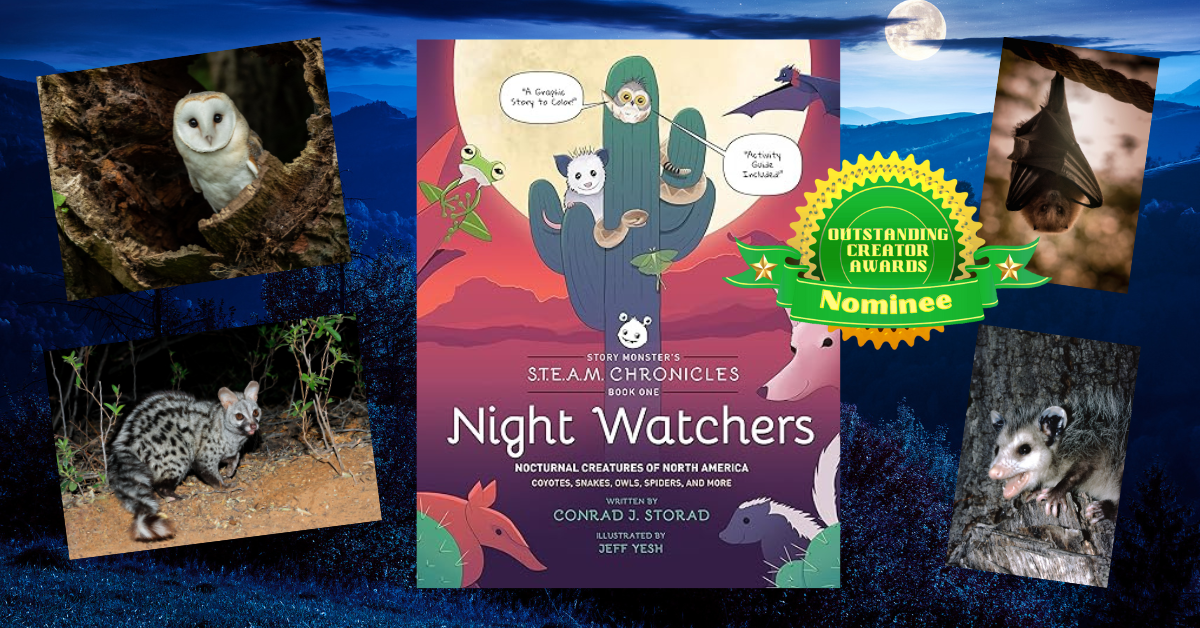
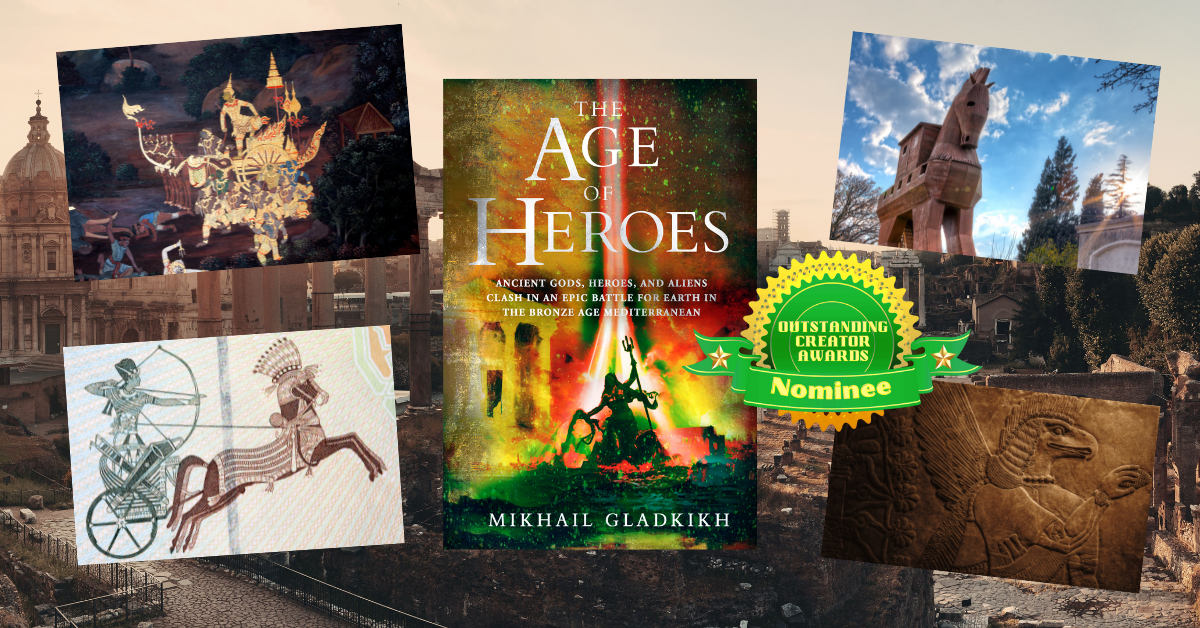
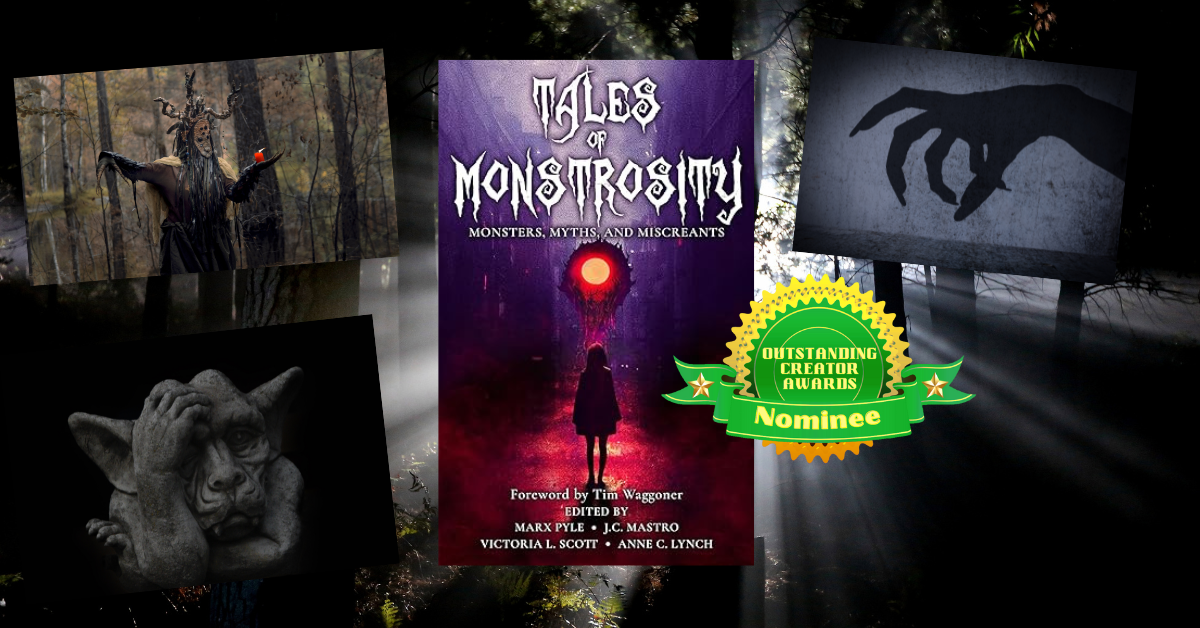

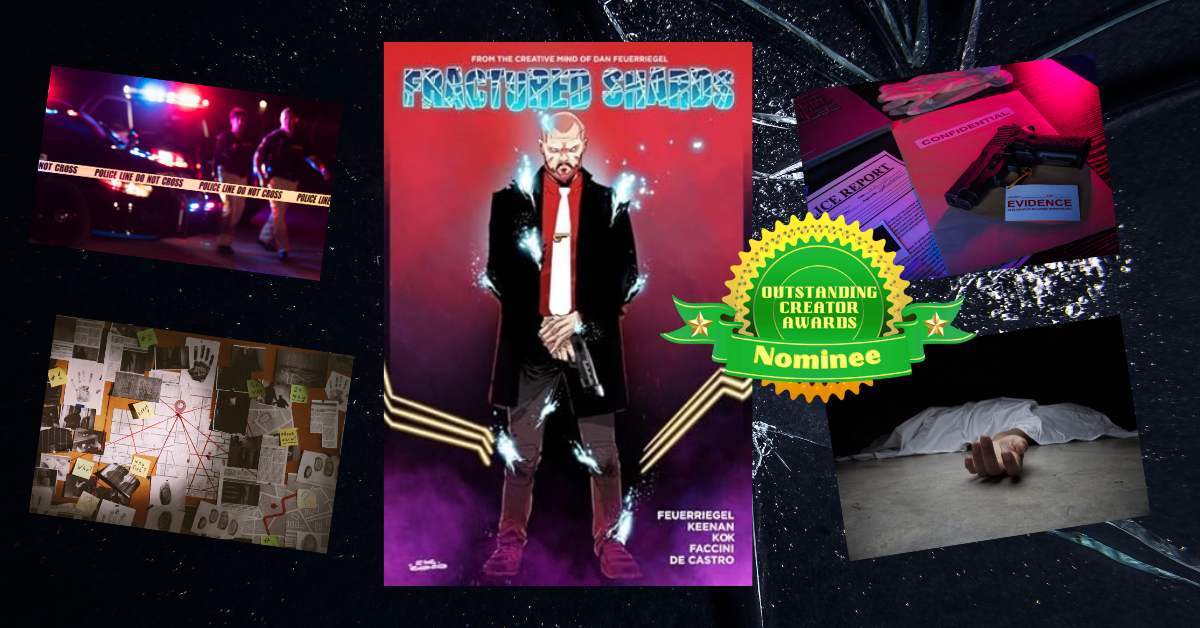

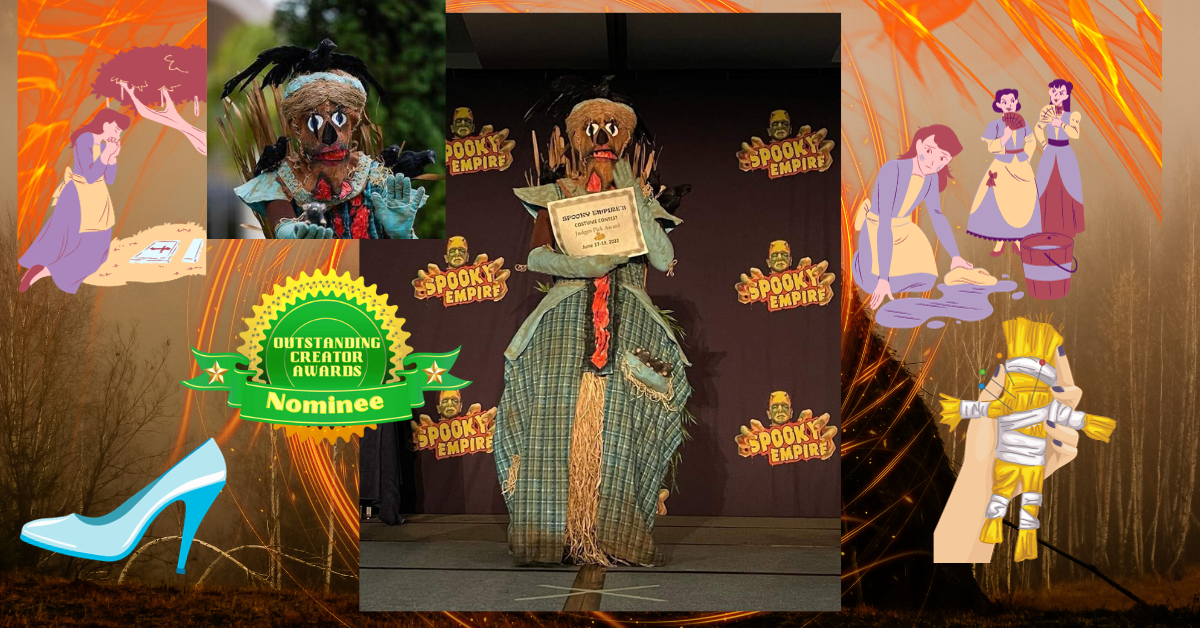
 RSS Feed
RSS Feed